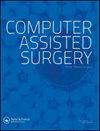How does adding anatomical landmarks as fiducial points in the point-matching registration of neuronavigation influence registration accuracy?
IF 1.9
4区 医学
Q3 SURGERY
引用次数: 6
Abstract
Abstract Skin markers (SMs) are usually used as fiducial points in registration of neuronavigation, but the areas in which they can be adhered to are restricted, which usually results in poor distribution of the SMs and a large registration error. In this research, we studied whether the registration accuracy can be improved by adding anatomical landmarks (ALs), which are thought to have a larger localization error than SMs. A series of random SM configurations were generated, and for each SM configuration, we generated a corresponding SM-AL configuration by adding several ALs. We then compared the accuracy of the point-matching registration of the SM configurations with that of the corresponding SM-AL configurations. Experiment results indicated that adding ALs always made the mean target registration error of the whole head fall into a lower and narrower range, which meant that the registration became more accurate and more stable. In addition, adding more ALs resulted in a better performance.在神经导航点匹配配准中加入解剖地标作为基准点对配准精度有何影响?
摘要在神经导航配准中,皮肤标记物通常被用作基准点,但皮肤标记物粘附的区域受到限制,导致皮肤标记物分布不均匀,配准误差大。在本研究中,我们研究了是否可以通过添加解剖标志(ALs)来提高配准精度,解剖标志被认为比SMs具有更大的定位误差。生成一系列随机SM配置,对于每个SM配置,我们通过添加几个al生成相应的SM- al配置。然后,我们比较了SM配置与相应的SM- al配置的点匹配配准精度。实验结果表明,加入al总能使整个头部的平均目标配准误差下降到一个更低、更窄的范围内,这意味着配准更加准确和稳定。此外,添加更多的al会带来更好的性能。
本文章由计算机程序翻译,如有差异,请以英文原文为准。
求助全文
约1分钟内获得全文
求助全文
来源期刊

Computer Assisted Surgery
Medicine-Surgery
CiteScore
2.30
自引率
0.00%
发文量
13
审稿时长
10 weeks
期刊介绍:
omputer Assisted Surgery aims to improve patient care by advancing the utilization of computers during treatment; to evaluate the benefits and risks associated with the integration of advanced digital technologies into surgical practice; to disseminate clinical and basic research relevant to stereotactic surgery, minimal access surgery, endoscopy, and surgical robotics; to encourage interdisciplinary collaboration between engineers and physicians in developing new concepts and applications; to educate clinicians about the principles and techniques of computer assisted surgery and therapeutics; and to serve the international scientific community as a medium for the transfer of new information relating to theory, research, and practice in biomedical imaging and the surgical specialties.
The scope of Computer Assisted Surgery encompasses all fields within surgery, as well as biomedical imaging and instrumentation, and digital technology employed as an adjunct to imaging in diagnosis, therapeutics, and surgery. Topics featured include frameless as well as conventional stereotactic procedures, surgery guided by intraoperative ultrasound or magnetic resonance imaging, image guided focused irradiation, robotic surgery, and any therapeutic interventions performed with the use of digital imaging technology.
 求助内容:
求助内容: 应助结果提醒方式:
应助结果提醒方式:


